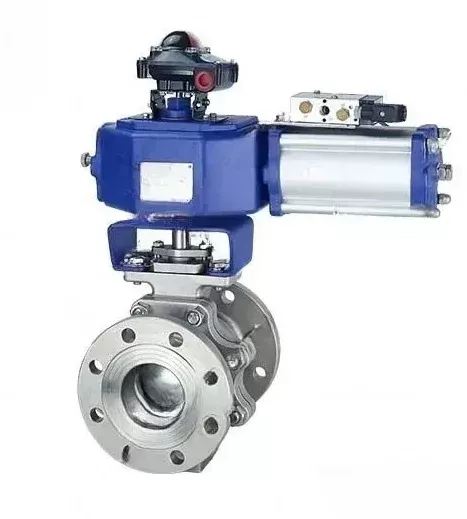Notifications

8 minutes, 18 seconds
-36 Views 0 Comments 0 Likes 0 Reviews

Introduction
Pneumatic ball valves are integral to modern fluid and gas control systems. These China Control Valves manage the flow of liquids and gases through pipelines using a rotating ball mechanism, which either allows or blocks the flow. The versatility of pneumatic ball valves lies in their integration with pneumatic actuators, which convert compressed air into mechanical motion to control the ball’s rotation. They offer several advantages, including ease of use, reliability, and cost-effectiveness, making them a popular choice across diverse industrial applications.
In this article, we’ll delve into the mechanics of pneumatic ball valves, explore their components, discuss installation considerations, and provide maintenance tips to ensure long-term efficient operation.
What is a Pneumatic Ball Valve?
A pneumatic ball valve consists of two primary components: the ball valve itself and the pneumatic actuator. The valve features a hollow, spherical ball with a hole (or bore) in the middle. When the valve is open, the hole aligns with the flow path, allowing fluid to pass. Turning the valve rotates the ball 90 degrees, either allowing or blocking the flow depending on the ball’s position.
The pneumatic actuator controls the ball’s rotation by using compressed air. These actuators convert air pressure into mechanical motion, turning the ball valve. Pneumatic actuators can be:
Single-Acting Actuator: Requires compressed air to move the ball in one direction. When air is removed, a spring returns the valve to its default position, making it ideal for fail-safe applications.
Double-Acting Actuator: Uses compressed air to move the ball in either direction. This actuator is suitable for applications requiring greater control over the flow direction.
Pneumatic ball valves offer a quick response time and are typically more cost-effective than electric actuated valves, especially in larger sizes. They are known for their durability and ability to handle high-pressure and high-temperature conditions.
Pneumatic Actuator: The actuator converts compressed air into motion to rotate the ball valve. It’s mounted on top of the valve using a flange that adheres to the ISO 5211 standard, ensuring compatibility with other actuators.
Ball Valve: The core element features a rotating ball with a hole in the middle. When aligned with the flow path, the valve opens, allowing fluid to pass. When turned 90 degrees, the ball blocks the flow.
ISO 5211 Flange: This flange standard ensures compatibility between the actuator and the ball valve, making it easier to replace actuators of the same size.
Spring and Seals: Springs and seals maintain valve integrity, ensuring a tight seal during operation and enabling the actuator to return the valve to its default position in single-acting systems.
Flanged Pneumatic Ball Valves: These involve two pipelines fitted with flanges, secured with gaskets and bolts to form a removable joint. This method is easy to install and disassemble.
Threaded Pneumatic Ball Valves: Featuring threaded ends, these valves connect easily to pipes, providing a reliable, leak-proof seal. Ideal for smaller systems or applications with limited space.
Tri-Clamp Pneumatic Ball Valves: Common in sanitary applications, these valves use a clamp to secure the valve between two pipe ends, ensuring quick and hygienic connections.
Wafer-Type Pneumatic Ball Valves: Mounted between two flanges using bolts, wafer-type valves offer a compact and cost-effective solution.
Welded Pneumatic Ball Valves: Permanently welded to pipes, these valves provide a strong, leak-free connection, especially suitable for high-pressure applications.
The operation of a pneumatic ball valve is straightforward. The ball valve is mounted in a pipeline, and the pneumatic actuator controls the valve’s position. When compressed air is supplied to the actuator, it moves the valve into either the open or closed position:
Open Position: The hole in the ball aligns with the flow path, allowing fluid or gas to flow.
Closed Position: The ball rotates 90 degrees, blocking the flow completely.
This simple design makes pneumatic ball valves reliable and effective in industries such as water treatment, chemical processing, and oil and gas.
Several factors need to be considered for the proper installation of pneumatic ball valves:
Environment and Safety: Ensure the valve components are rated for the temperature, pressure, and type of fluid or gas being handled. Follow safety protocols, such as wearing protective gear when handling lubricants or solvents.
Compatibility: Verify that the pneumatic actuator and ball valve are compatible with your system’s pressure and temperature ratings. Ensure proper fitment of all connections to prevent leakage.
Ease of Maintenance: Consider the long-term maintenance of the valve. Ensure access for regular inspections, cleaning, and lubrication.
Proper maintenance ensures that pneumatic ball valves function efficiently over time. Here are some essential tips:
Regular Inspections: Check for signs of damage, corrosion, or wear. Early detection of problems can prevent downtime or costly repairs.
Check for Leaks: Inspect seals, gaskets, and connections for leaks. Tighten loose connections and replace seals as needed to maintain optimal performance.
Lubrication: Regularly lubricate the actuator’s internal components to ensure smooth operation. Use lubricants compatible with your system.
Monitor Air Supply: Ensure the compressed air supply is clean and dry. Contaminants in the air can damage the actuator and other components.
Troubleshooting Malfunctions: If a malfunction occurs, consult the manufacturer’s documentation for troubleshooting advice. If necessary, seek assistance from a qualified technician.
Avoid Overloading: Ensure the valve is properly sized for your system to prevent overloading, which could lead to premature failure.
Pneumatic ball valves are essential in controlling fluid and gas flow across various industries. Their simplicity, reliability, and cost-effectiveness make them a preferred option for applications in water treatment, chemical processing, and oil and gas pipelines. By understanding their components, installation considerations, and maintenance practices, you can ensure your pneumatic ball valve operates efficiently for many years. Regular inspection and proper installation are crucial for maintaining optimal performance and preventing costly downtime.Know more about Google SEO Directory

